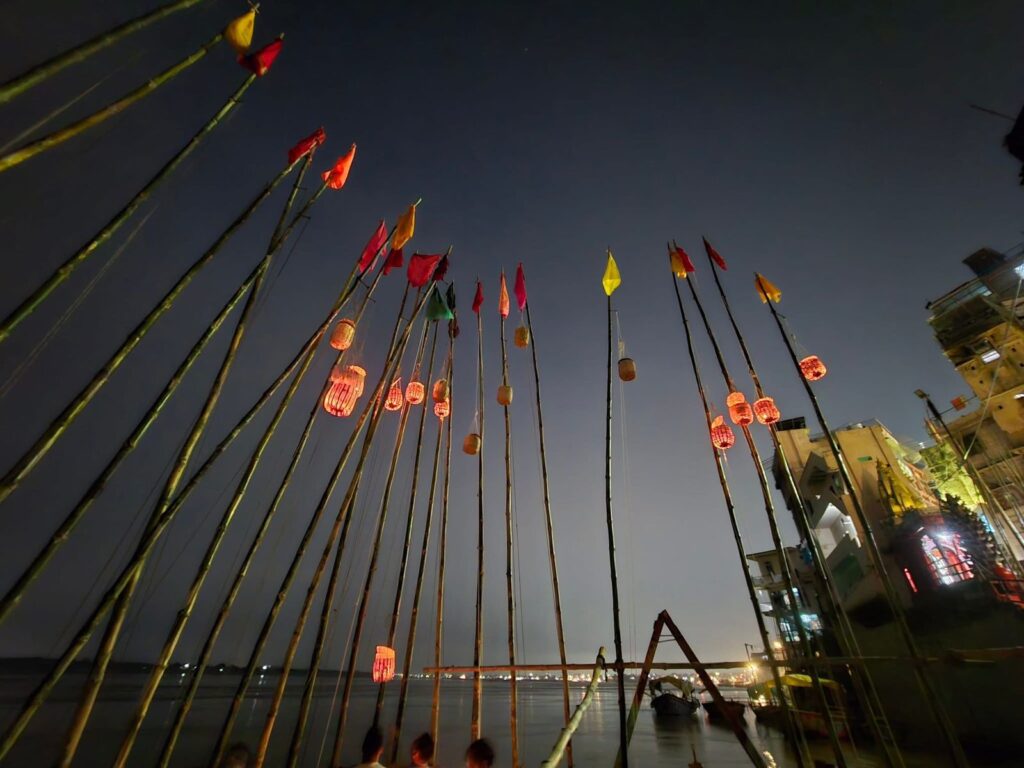When you sail along the ghats of Varanasi, one sacred spot catches your eye — Panchganga Ghat, the confluence of five holy rivers and a symbol of spiritual purity. This isn’t just a riverbank — it’s where faith, mythology, and history merge seamlessly.
In this post, let’s walk through the story of Akashdeep at Panchganga Ghat, with gentle references from the Kashi Khanda of the Skanda Purana, and understand why this divine corner of Kashi holds timeless power.
The Sanctity of Panchganga Ghat
According to ancient texts, Panchganga Ghat marks the meeting of five sacred rivers — Ganga, Yamuna, Saraswati, Dhutapapa, and Kirana.
Today, only the Ganga flows visibly, while the others are believed to move in subtle, underground streams. This belief is why the site is called Panchganga — the “fivefold Ganga.”
In the Kashi Khanda of the Skanda Purana, Panchganga is described as a divine manifestation born from the descent of the Ganga herself:
काशी खण्ड के अनुसार:
“…अद्य गङ्गाावतारात् काश्याम् पंचगंगा प्रकटिता।”
“Adaya Gangaavatarat Kasyam Panchaganga Prakatita”
Translation: “When the Ganga descended upon earth, Panchganga manifested in Kashi.”
This verse beautifully expresses that the sacredness of this place is not just physical — it’s a celestial reflection of the divine Ganga’s presence.
A Morning with Akashdeep at the Ghat
The Journey Begins
At dawn, I took a boat along the Ganga. The mist hovered above the water, and temple bells echoed through the silence. As the boat approached Panchganga Ghat, the soft sunlight kissed the ancient steps, and the gentle river breeze felt like a blessing.
Stepping ashore, I saw devotees bathing, priests performing rituals, and walls carved with faded deities and floral designs — each telling a silent story from centuries past.
The Holy Dip and a Prayer
I joined the ritual bath — a dip that cleanses not only the body but also the soul. While standing in the sacred water, I whispered an old local verse often recited here:
“नमो घाटाय किंकराय, प्रयातार्थ यदि व्रजामि |
पंचगंगे शिवयक्ष्येति, मम मोक्षः सिद्ध्यति ध्रुवम् ||”“Namo Ghataya Kinkaraya, Prayatarth Yadi Vrajami |
Panchagange Shivayakshyeti, Mama Mokshah Siddhyati Dhruvam ||”
Meaning: “O holy ghat, I bow to you. If I depart having bathed in your sacred waters, may I find liberation through the grace of Shiva at Panchganga.”
It’s not from a specific scripture but a heartfelt invocation that echoes the local faith — that a sincere bath here brings one closer to moksha, or liberation.
Temple Visit and Timeless Architecture
Above the ghat stands the Bindu Madhav Temple, once among Kashi’s grandest shrines. Over centuries, invasions and rulers altered its structure, and today, beside the temple stands the Alamgir Mosque, built in the Mughal era.
Their coexistence is a rare blend of Hindu and Islamic architecture — domes, arches, and carvings forming a living heritage of India’s layered past.
Evening Aarti – The Divine Glow
By evening, the ghat transforms into a radiant spectacle. The Ganga Aarti begins — oil lamps flicker in priestly hands, chants echo across the water, and hundreds of diyas float away like golden stars. Watching it from a boat, I felt that this light wasn’t just illuminating the river — it was awakening something deep within.

Mythological and Historical Significance
- Mention in the Skanda Purana
The Kashi Khanda narrates that Panchganga appeared during the divine descent of Ganga, making it one of the most sacred bathing sites in Kashi. - Associated Saints and Scholars
Many saints, including Sant Ramananda and Kabir Das, are said to have meditated and preached here. Their spiritual legacy adds another layer of reverence to the site. - Temple Transformations Through Time
The original Bindu Madhav Temple was damaged during medieval invasions but later revived by local devotees. The mosque that stands nearby is known as Beni Madhav-ka-Darera, a reminder of history’s ebb and flow. - Symbol of Liberation (Moksha)
As per ancient belief, bathing at Panchganga is equivalent to bathing in all five sacred rivers. The act symbolizes purification of sins and elevation of the soul toward salvation.
Travel Tips for Visiting Panchganga Ghat
- Arrive Early Morning: Experience the serenity before crowds gather.
- Witness the Evening Aarti: Watching it from a boat is an unforgettable sight.
- Observe Architecture: Don’t miss the fusion of Hindu and Mughal styles.
- Respect Local Customs: Take photos mindfully and maintain silence during rituals.
- Hire a Local Guide: They often share fascinating legends from Kashi Khanda.
- Best Time to Visit: The Kartik month (October–November) is especially auspicious when devotees light thousands of diyas along the ghats.
Conclusion – A Light Beyond Time
Panchganga Ghat is not just a riverbank — it is a spiritual bridge between heaven and earth.
As I lit my Akashdeep (sky lamp) and placed it on the river, I watched it drift slowly, carrying my prayers and gratitude to the heart of the Ganga.
Every ripple, every chant, every lamp told the same story — that Kashi is eternal, and the divine light of Panchganga continues to shine through the ages.
So when you visit Varanasi, don’t just see Panchganga Ghat — feel it.
Because here, every wave whispers the same ancient truth —
“This is not just water; this is liberation flowing.”


